Customers who were subjected to the hard sale strategy frequently felt under pressure, uneasy, and even tricked. However, with so many options available to consumers in today’s market, this antiquated approach is no longer viable. The “Customer Centric” approach is currently becoming more and more popular among prosperous companies. Instead than only attempting to close a deal, it places a strong emphasis on understanding the problems of the consumer and providing solutions.
And if you haven’t yet, I am telling you, adopting this method will help you stand out from the competition in this fast-paced, highly competitive environment when attention spans are short. You’ll witness not just a rise in customer satisfaction but also a rise in loyalty and word-of-mouth advertising from happy clients. Therefore, give up on outmoded strategies like pushy sales pitches and embrace the ability to solve issues for your cherished customers.
The Shift From Selling to Solving
The traditional approach to sales has always revolved around the concept of “selling.” It’s all about convincing people to buy a product or service, pushing it onto them, and using persuasive tactics to close the deal.
However, in recent years there has been a shift towards a more customer-centric approach – one that focuses on solving problems rather than just selling products. So what exactly is the difference between “selling” and “solving”?
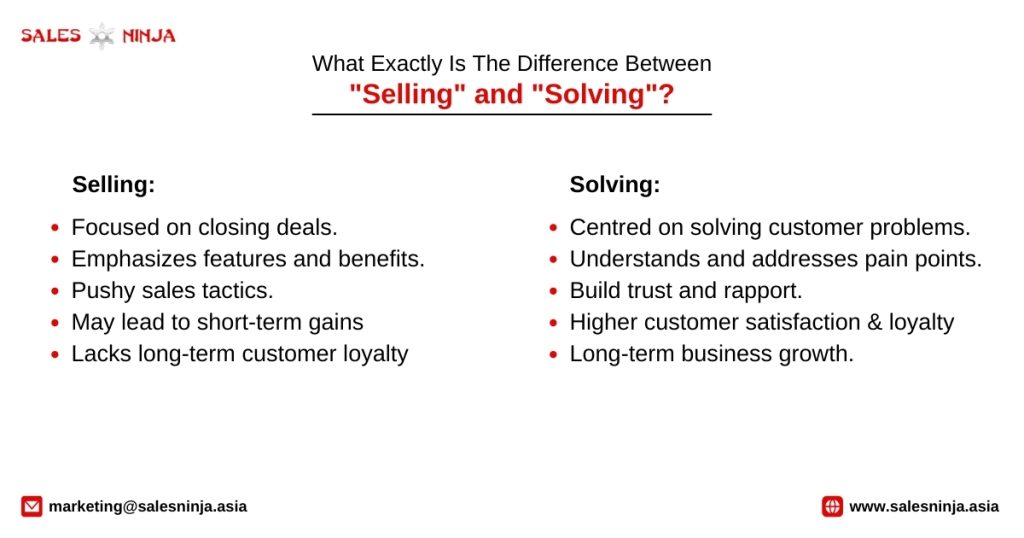
Selling is essentially transactional in nature – it’s about exchanging goods for money. On the other hand, solving involves understanding your customers’ needs and finding ways to address those needs through your product or service. This shift from focusing solely on making a sale to actually providing value and solving problems for customers can make a significant impact on how businesses are perceived by their target audience.
One major reason behind this change in mindset is because consumers have become increasingly skeptical of traditional sales tactics. They no longer want to be bombarded with advertisements and aggressive pitches; instead, they want brands that genuinely care about their needs and offer solutions that align with their values.
Moreover, many people associate salespeople with being pushy or manipulative. In fact, studies have shown that only 3% of buyers trust salespeople (HubSpot). This negative perception makes it even harder for businesses relying solely on selling techniques to build long-term relationships with their customers. On the other hand, when companies adopt problem-solving as part of their strategy, they not only improve brand reputation but also build strong relationships based on trust and authenticity. By truly listening to their customers’ pain points and offering tailored solutions rather than trying to sell something at any cost, these businesses differentiate themselves from others who continue using outdated methods.
In fine, shifting focus from selling to solving can help your businesses win hearts (and wallets) by building stronger connections with their target market. A genuine desire to solve problems for your customers shows integrity and builds credibility – two essential components of successful and sustainable business. So, let’s embrace this new era of selling less and solving more!
The Value of Understanding Customer Pain Points and Needs
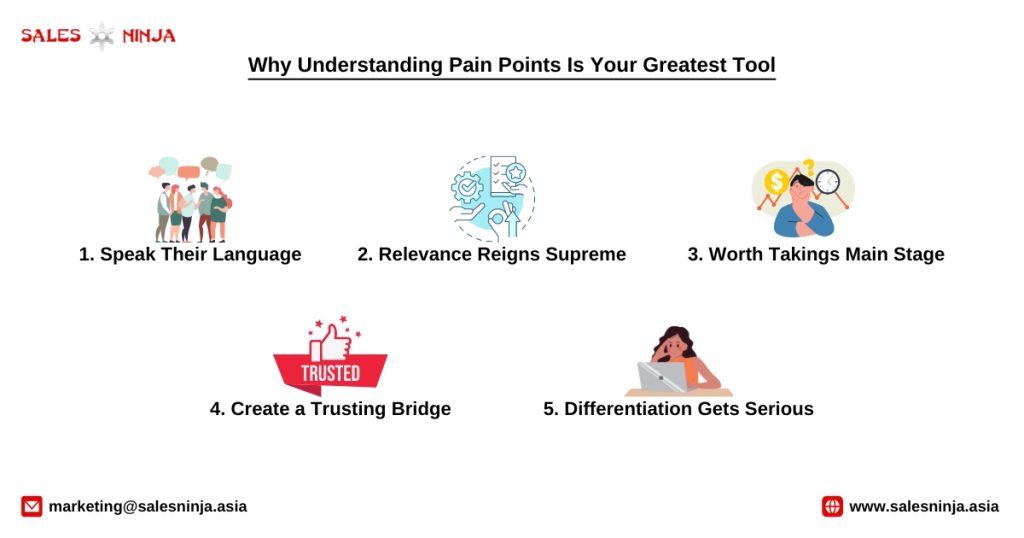
Alright, so we now know that the winning strategy is “sell less, solve more”. But how can we actually live out that change? Everything begins with a thorough exploration of the complex demands and pain areas of the consumer. This isn’t a leisurely plunge; instead, we’re going deep for insights, so buckle up.
Imagine you barrage a potential buyer with features and advantages—a visually stunning demonstration of “why they need your product.” Yes, that’s stunning, but does it really make sense? Does it deal with the insomnia brought on by a particular problem they encounter? Most likely not.
Here’s why understanding pain points is your greatest tool:
1. Speak Their Language: Imagine a conversation where you only talk about yourself. Not exactly captivating, right? The same goes for sales pitches. By understanding their struggles, frustrations, and aspirations, you speak their language – the language of their problems. Now you’re having a real conversation, building trust and rapport.
2. Relevance Reigns Supreme: Features are cool, but relevance is king. When you pinpoint their specific pain points, your solution transforms from “interesting” to “life-changing.” It becomes the answer they’ve been searching for, not just another option in a crowded marketplace.
3. Worth Takings Main Stage: Put aside generalized value statements. You may show them how much actual value your product or service offers by catering to their specific demands. The solution to the issue that keeps people up at night is more important than all the bells and whistles. They may experience that value rather than just hear it.
4. Create a Trusting Bridge: You demonstrate a sincere interest in someone else’s well-being rather than just their pocketbook when you actively listen and try to understand them. This cultivates trust, which is essential to any long-term partnership. They perceive you not as a salesperson but as someone who genuinely cares.
5. Differentiation Gets Serious: Honestly, there is a lot of competition. However, you may customize solutions that make you stand out if you are aware of their unique needs. It’s not only about being superior; it’s also about offering the most pertinent answer to their particular problems.
Benefits of Selling Less, Solving More
We now need to make clear how big of a benefit the “Selling Less, Solving More” strategy offers, as we have established that it is the optimal strategy. Let’s divide the advantages into two categories.
For the customer:
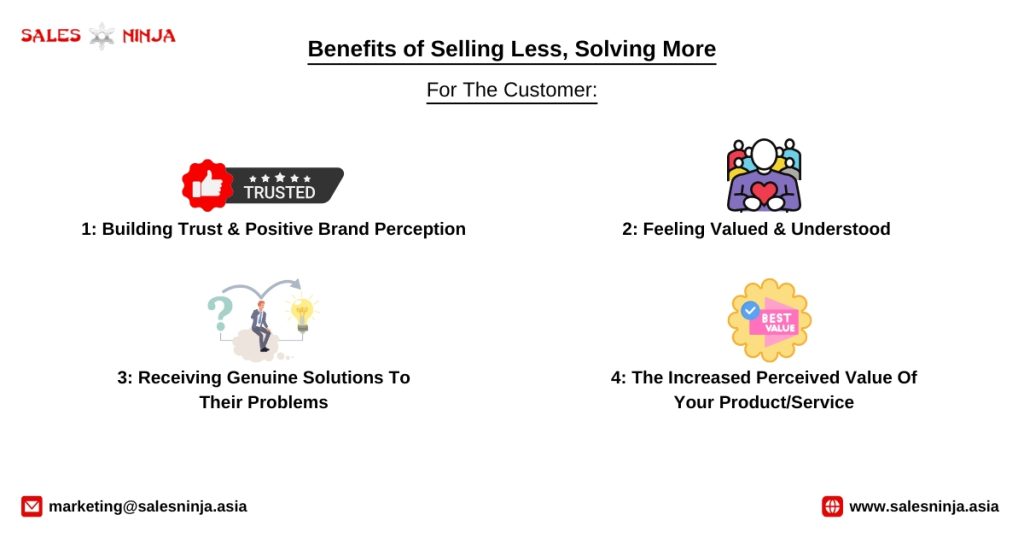
1. Building trust and positive brand perception: When businesses prioritize solving customers’ problems over making a sale, it fosters trust and contributes to a positive brand perception. By demonstrating a genuine interest in addressing customers’ needs rather than pushing products or services, businesses establish themselves as reliable and customer-centric entities.
2. Feeling valued and understood: Implementing a “sell less, solve more” approach signals to customers that their concerns and preferences are genuinely valued by the business. By taking the time to listen actively, empathize with their challenges, and offer personalized solutions, businesses show that they understand and care about their customers’ well-being, fostering a sense of appreciation and importance.
3. Receiving genuine solutions to their problems: Customers appreciate when businesses prioritize providing genuine solutions that effectively address their specific problems and requirements. Thus, businesses demonstrate their commitment to delivering tangible value rather than merely pushing products or services for the sake of a sale.
4. The increased perceived value of your product/service: By emphasizing the benefits and outcomes of their products or services in solving customers’ problems, businesses differentiate themselves from competitors and position their offerings as indispensable solutions rather than mere commodities. This increased perceived value leads to greater customer satisfaction and loyalty.
For your business:
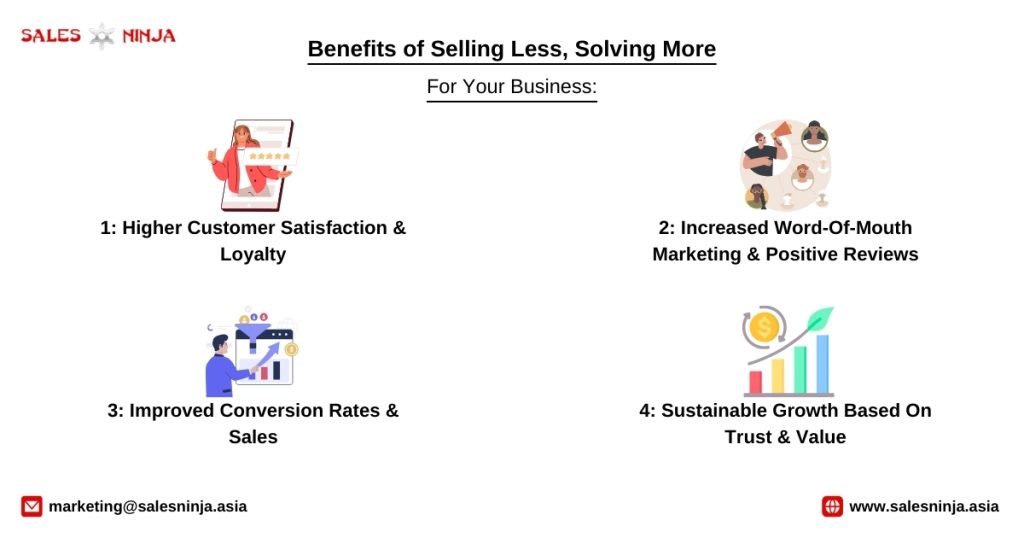
1. Higher customer satisfaction and loyalty: When businesses prioritize solving customers’ problems over aggressive selling tactics, it results in higher levels of customer satisfaction. Satisfied customers are more likely to remain loyal to the brand, leading to repeat purchases and long-term relationships.
2. Increased word-of-mouth marketing and positive reviews: Adopting a customer-centric approach and focusing on solving customers’ problems can lead to positive word-of-mouth marketing and glowing reviews. Satisfied customers are more inclined to share their positive experiences with others. Whether through recommendations to friends and family or online reviews and testimonials. This organic promotion can significantly enhance the brand’s reputation and attract new customers without the need for costly advertising campaigns.
3. Improved conversion rates and sales: When customers feel understood and valued, they are more likely to trust the brand and make a purchase. Additionally, offering genuine solutions that address their pain points increases the perceived value of the product or service, making it more compelling and persuasive. This results in higher conversion rates and increased sales revenue for the business.
4. Sustainable growth based on trust and value: Prioritizing customer satisfaction and focusing on providing meaningful solutions, businesses establish themselves as trustworthy and reputable entities in the market. This trust, coupled with the perceived value of the offerings, fosters customer loyalty and encourages repeat business. Over time, sustainable growth becomes achievable as the business continues to meet and exceed customer expectations. Driving positive outcomes and fostering long-term success.
How to Implement “Sell Less, Solve More”
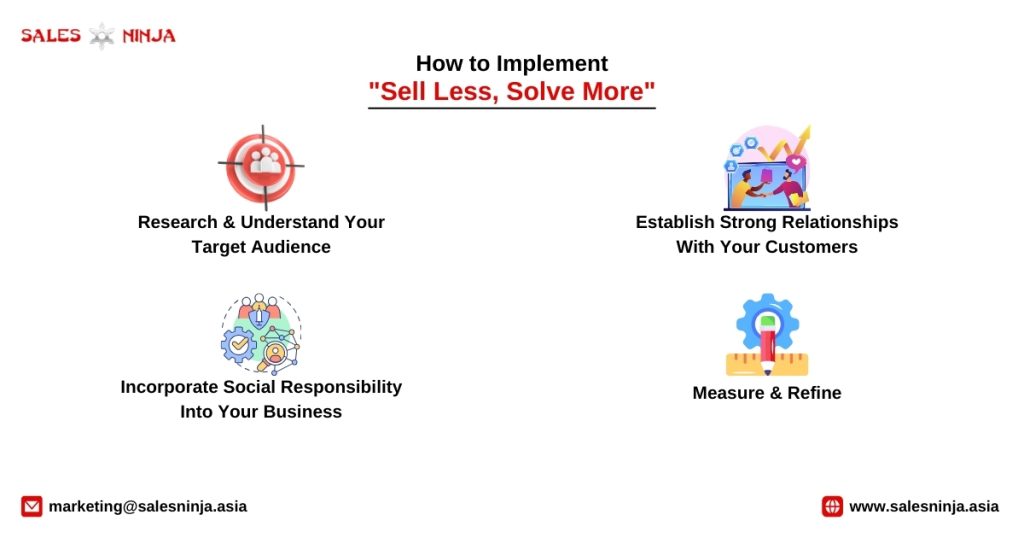
“Sell less, Solve more” – but how do you translate this philosophy into actual action? Implementing this approach requires a shift in mindset and strategy. Instead of focusing solely on selling products or services, businesses should prioritize solving their customers’ problems and needs.
One way to implement this is by conducting thorough research and understanding your target audience’s pain points. This could include surveys, customer feedback, market trends analysis, etc. For example, if you own a clothing brand catering to young professionals who value comfort over style. It would be important to understand what specific features they look for in comfortable clothing (e.g., soft fabric, stretchy material) rather than just promoting the latest fashion trends.
Another key aspect of implementing this approach is establishing strong relationships with your customers through excellent customer service. This means actively listening to their concerns and offering tailored solutions instead of simply trying to sell them something that may not meet their needs. Going back to our previous example, if a customer expresses dissatisfaction with the fit of one of your shirts. Don’t just try to convince them it looks good on them – offer alternative options that better suit their preferences.
Additionally, incorporating social responsibility into your business can also help align with the “solve more” aspect of this approach. Consumers are increasingly drawn towards companies that have a positive impact on society and the environment. By addressing societal issues or supporting charitable causes relevant to your target audience’s values. You are not only gaining loyal customers but also making a difference in people’s lives.
Measure and Refine. Monitor feedback, conduct surveys, and measure key metrics. Like customer lifetime value and Net Promoter Score to gauge the impact of your new approach.
Overall, it requires putting yourself in your customers’ shoes and prioritizing meeting their needs above pushing sales goals. By doing so authentically and consistently demonstrating genuine care for their well-being both as consumers and individuals. You will ultimately win both hearts and wallets.
Customers Crave Understanding and Solutions, Not Just Sales Pitches
The truth is, a genuine desire to solve problems for your customers shows integrity and builds credibility. Two essential components of a successful and sustainable business. So, let’s embrace this new era of selling less and solving more!
Visit our website to explore valuable resources and insightful articles. Subscribe to our LinkedIn newsletter and get regular updates, success stories, and exclusive tips delivered straight to your inbox.






Leave A Comment